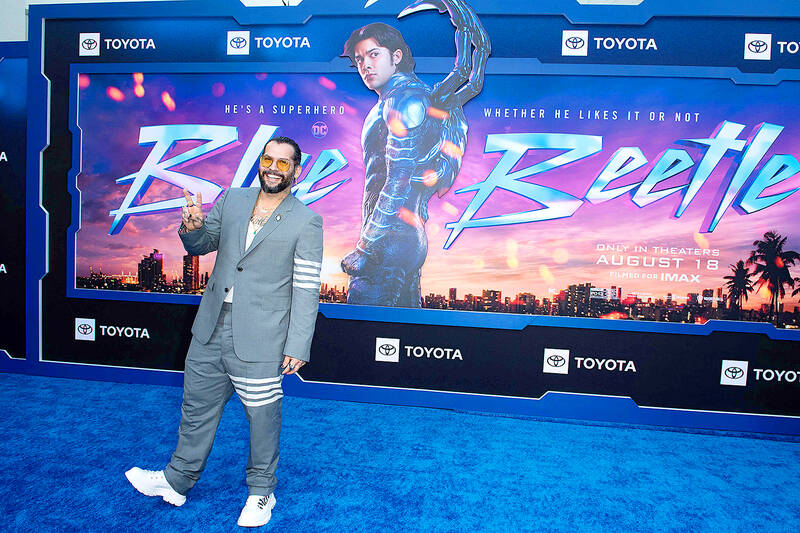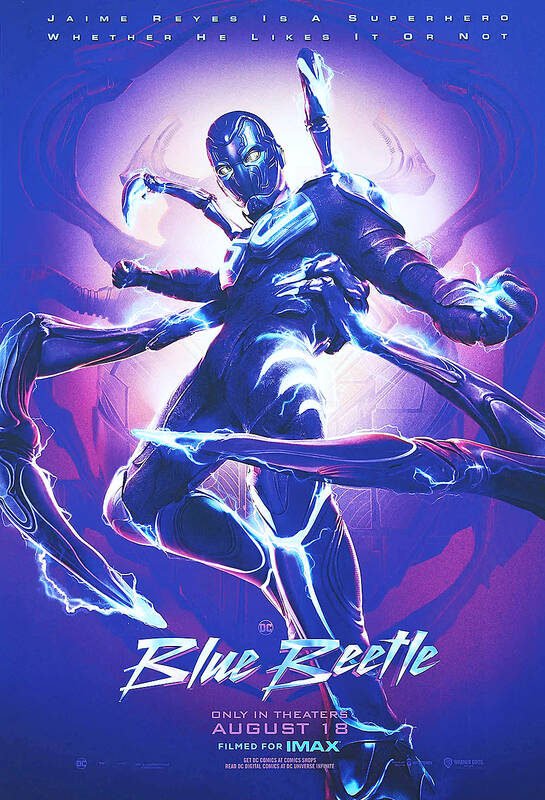Franz Kafka never realized how close he came to kickstarting a superhero franchise.
Ever since Gregor Samsa awoke in his bed to find himself transformed into a monstrous dung beetle in The Metamorphosis, we’ve had spider-men, wasps, ant-men, crime-fighting ticks and mighty mantises — such a super swarm of insectoids that you might be tempted to reach for a fly swatter.
We’re now back to the beetle with the new DC Comics film Blue Beetle, which is in theaters. But what distinguishes Blue Beetle isn’t its place in the bug brigade but the person doing the metamorphosizing.

Photo: AFP
Jaime Reyes (Xolo Mariduena) is the first Latino superhero in a leading role in a DC film. It’s not just token casting, either. Blue Beetle, directed by Angel Manuel Soto and written by Gareth Dunnet-Alcocer, is firmly rooted in the experience of the Reyes clan, a close-knit Mexican-American family scraping by in the shadow of the gleaming Miami-like fictional metropolis of Palmera City.
Jaime is their first college graduate — “And last!” cheerfully chimes his sister, Milagro (the very funny, scene-stealing Belissa Escobedo). The parents, Alberto (Damian Alcazar) and Rocio (Elpidia Carrillo) are broke and on the cusp of losing their home to the encroaching, all-powerful Kord Industries. Also living with them are Jaime’s grandmother (Adriana Barraza) and his truck-driving uncle (George Lopez, having a ball).
“We used to have the other side of the tracks,” says Milagro. “Now they want that, too.”

Photo: AFP
Despite big post-college ambitions, Jaime is stuck cleaning hotel rooms with his sister. Given what his family has sacrificed for him, he’s saddled with guilt. So after a chance encounter with Jenny Kord (the Brazilian actress Bruna Marquezine), niece of the company’s imperial chief executive Victoria (Susan Sarandon), Jaime jumps at the chance of a job opportunity.
He happens to turn up at Kord headquarters just as Jenny is fleeing with Victoria’s prized discovery: a blue metallic scarab from outer space called the Khaji da that she’s using to create an privatized robotic army. It’s admittedly quite a jump from the real estate business, but, well, interest rates are sky high.
Before you know it, Jaime, tasked with hiding the beetle by Jenny, is looking down at the thing when it sinks itself onto his face and quickly seeps into his body. Gregor’s initial response to changing into a beetle was simply to turn over (“How about if I sleep a little bit longer and forget all this nonsense”), but Jaime is afforded no such chance. He’s immediately rocketed through the roof and into space.
In the broadly sketched but spirited Blue Beetle, much of what follows is as you’d expect. There’s getting used to the new outfit (and the sentient being that communicates Venom-style within Jaime). A recent past to uncover. The inevitable climactic battle between two hunks of CGI.
But Blue Beetle, the final entry in a now defunct wave of DC films, distinguishes itself in other ways. Jaime’s family is continually along for the ride, making up his supporting cast when the big fight comes. (The grandmother’s younger days as a revolutionary emerge, comically.) Superheroes are ultimately empowerment fantasies, though they’ve often got away from that. Blue Beetle manages to come closer than most in evoking the thrill of the powerless suddenly handed cosmic strength.
Soto plays it fast and loose, mixing in a little lewdness (“Activate bug fart” is a new addition to the often solemn DC universe) and shades of neon blue and purple along the way. Blue Beetle doesn’t have much originality going for itself and Mariduena doesn’t make a significant impression. But the film crucially gets that superhero movies don’t need to be self-serious to make a serious point.
Blue Beetle, light, lively and sincere, is a tribute to the tenacity and indomitability of Mexican-American families that have clawed their way into an often inhospitable society. Family members, usually plot points of some animating trauma in superhero movies, are here a central part of the action. (Lopez gets countless cracks in, and most of them land.)
It’s a time of self-inquiry for the superhero movie after hints of a new downward trend (despite some notable exceptions like the blistering Spider-Man: Across the Spider-Verse, with its Afro-Latino protagonist ). Blue Beetle, which had at one point been destined to go straight to streaming, falls in the middle of this new uncertain terrain. After a string of disappointments, future DC installments will take the comic book franchise in new directions. So it remains to be seen if Blue Beetle can be much more than a bug in the system amid larger industry shifts.
But I’d wager there will be plenty of moviegoers — especially young Hispanic ones not accustomed to seeing reflections of themselves in Hollywood comic book spectacles — who’ll grin all the way through the breezy Blue Beetle. If even a low-stakes, fairly derivative superhero movie like this can charm thanks to its warm Hispanic perspective and winning supporting cast, there’s plenty of hope yet for the genre — bugs and all.

The canonical shot of an East Asian city is a night skyline studded with towering apartment and office buildings, bright with neon and plastic signage, a landscape of energy and modernity. Another classic image is the same city seen from above, in which identical apartment towers march across the city, spilling out over nearby geography, like stylized soldiers colonizing new territory in a board game. Densely populated dynamic conurbations of money, technological innovation and convenience, it is hard to see the cities of East Asia as what they truly are: necropolises. Why is this? The East Asian development model, with

June 16 to June 22 The following flyer appeared on the streets of Hsinchu on June 12, 1895: “Taipei has already fallen to the Japanese barbarians, who have brought great misery to our land and people. We heard that the Japanese occupiers will tax our gardens, our houses, our bodies, and even our chickens, dogs, cows and pigs. They wear their hair wild, carve their teeth, tattoo their foreheads, wear strange clothes and speak a strange language. How can we be ruled by such people?” Posted by civilian militia leader Wu Tang-hsing (吳湯興), it was a call to arms to retake

This is a deeply unsettling period in Taiwan. Uncertainties are everywhere while everyone waits for a small army of other shoes to drop on nearly every front. During challenging times, interesting political changes can happen, yet all three major political parties are beset with scandals, strife and self-inflicted wounds. As the ruling party, the Democratic Progressive Party (DPP) is held accountable for not only the challenges to the party, but also the nation. Taiwan is geopolitically and economically under threat. Domestically, the administration is under siege by the opposition-controlled legislature and growing discontent with what opponents characterize as arrogant, autocratic

When Lisa, 20, laces into her ultra-high heels for her shift at a strip club in Ukraine’s Kharkiv, she knows that aside from dancing, she will have to comfort traumatized soldiers. Since Russia’s 2022 invasion, exhausted troops are the main clientele of the Flash Dancers club in the center of the northeastern city, just 20 kilometers from Russian forces. For some customers, it provides an “escape” from the war, said Valerya Zavatska — a 25-year-old law graduate who runs the club with her mother, an ex-dancer. But many are not there just for the show. They “want to talk about what hurts,” she